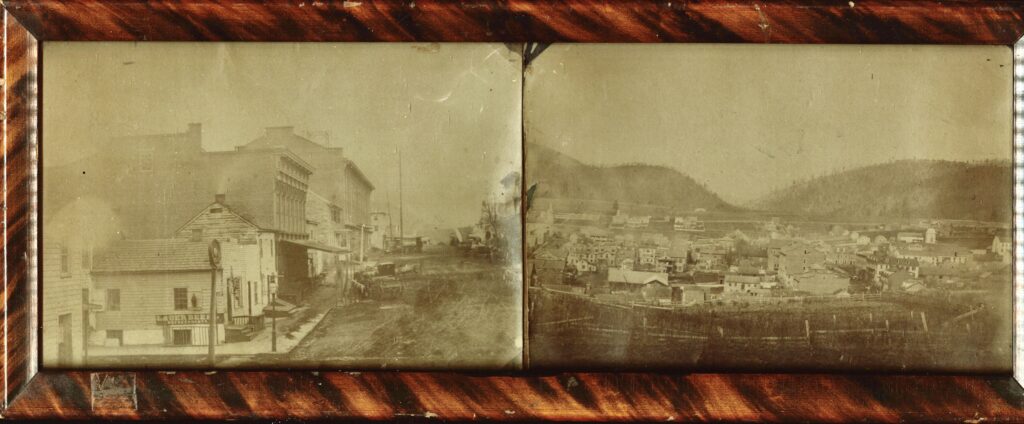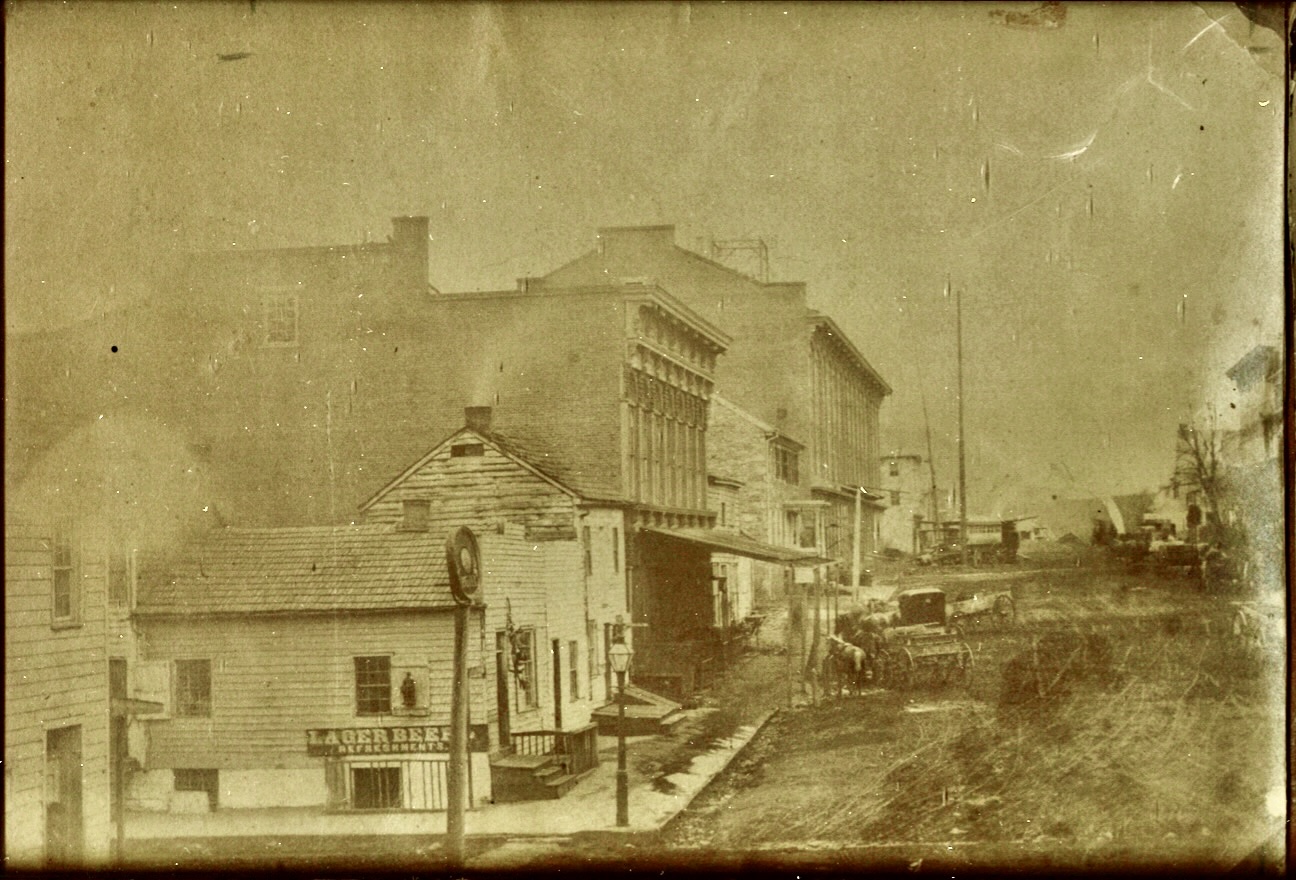An aged frame containing two sepia photographs is located in the Centre County Library & Historical Museum. They are believed to be the oldest known photographs of Bellefonte’s streetscape. Upon closer analysis, the photos come into focus and reveal some of their mysteries.
The infamous photo of Strychnine Corner was taken in 1865, along with a Reservoir Hill photo; both were framed together by photographer Charles A. Glenn. Glenn was an “old-time photographer” born in Boalsburg in 1833 who served in Co. H of the 4th PA Volunteers during the Civil War. After his enlistment, he took up photography and used a traveling cart to master his craft across Centre County.

The art of photography was a new science in the mid-1800s, and so were over-the-counter drugs. The phrase “Strychnine Corner” was being used in the 1860s to describe the northwest corner of Allegheny and Bishop streets. Although people were widely aware of its poisonous nature, strychnine was commonly used for pest control and even sold to “cure” various ailments. In the Victorian era, it was rumored that strychnine could serve as a sexual stimulant. The unique place name is fitting, concerning “the Corner” where one could easily choose their poison.
The Strychnine Corner comprised at least “eight bars, taverns, saloons, and associated activity,” according to the 1976 Fountain of Governors: The Story of Bellefonte, Pa. by the Bellefonte American Revolution Bicentennial Committee. “Brawls were frequent. A murder or two had origins on the Corner. Ladies of the town never ventured into the neighborhood without escorts. Some women, nevertheless (and allegedly, of course) did venture into the Corner and its establishments in search of escorts.”
In 1865, The Central Press lamented this part of town and criticized the local policemen who “wink at the wholesale violations of the law daily occurring under our immediate observations, in the low doggeries on Bishop Street. … We hope our leading citizens will get up a little courage and clean out the vile nest entirely. … We say it with shame, but with seriousness, that no lady can walk the pavements of one of our principal streets, at night, without being compelled to listen to the vilest language tongue can utter, or being exposed to outrageous insults. We call on our authorities to enforce the laws, and for decency’s sake, put an end to this condition of affairs.”
Upon examination of the Reservoir Hill photo, the wider landscape includes houses on Linn Street that were built in the 1850s, like those of F. Potts Green and Judge Samuel Linn. Homes that are not in the photo are those that came in 1868 with a post Civil War local housing boom, such as the homes of John Moran (North Allegheny Street), E.M. Blanchard (West Linn), J.P. Harris (West Linn), and others. What is more illuminating is the former Presbyterian Church. The white steeple and columned Presbyterian Church. on the blurry left of the photograph, would be completely replaced with the current brownstone edifice whose cornerstone was laid in 1868. Thus, Glenn’s photograph was taken before 1868.
Zooming in upon the other photo, looking up South Allegheny Street, you can see the Brockerhoff House under construction. A “Great Fire” in January 1864 had just destroyed the block, including the former Pennsylvania Hotel. Henry Brockerhoff was in the later stages of building a “new” Brockerhoff House in 1865. Also essential to the photo is the “Triumphal Arch” erected on the diamond for the “Soldiers Banquet” held in honor of returning Civil War soldiers on July 4, 1865. As in other towns, hundreds of soldiers marched the streets of Bellefonte amidst thousands of spectators on Independence Day 1865. A few months later, Glenn would go on to win $3 for “best photograph” at the state fair in Williamsport—perhaps for this very photo.
On a cold Sunday morning, February 2, 1868, reported the Democratic Watchman, “the mass of wooden buildings known here and throughout the county as ‘strychnine corner,’ was discovered to be in flames. … All the wooden buildings in reach were burned to the ground, and naught is left but the bleak walls and yarning cellars over which they stood.” The Strychnine Corner would never be the same.
Nor will any photograph replace the priceless work of Mr. Glenn. After a nomadic journey in photography, Charles Glenn would settle in Bellefonte for good in 1870, arriving with his “elegant picture car” and a reputation as one of the “finest photograph artists in the country,” even photographing the sick and dead. On New Year’s Day, 1919, Glenn died and was buried in Union Cemetery at the age of 85. A veteran and long-lived photographer, he must have witnessed a lot in his lifetime. T&G
Local Historia is a passion for local history, community, and preservation. Its mission is to connect you with local history through engaging content and walking tours. Local Historia is owned by public historians Matt Maris and Dustin Elder, who co-author this column. For more, visit localhistoria.com.
Sources:
“Address Delivered at the laying of the Corner Stone of the New Presbyterian Church in Bellefonte.” The Bellefonte National (Bellefonte, PA). Nov. 27, 1868. https://panewsarchive.psu.edu/lccn/sn85025168/1868-11-27/ed-1/seq-1/
Bellefonte American Revolution Bicentennial Committee. Fountain of Governors: The Story of Bellefonte, Pa. Bellefonte: 1976.
Democratic Watchman (Bellefonte, PA). July 14, 1865.
https://panewsarchive.psu.edu/lccn/sn83031981/1865-07-14/ed-1/seq-3/
Democratic Watchman (Bellefonte, PA). Feb. 7, 1868.
https://panewsarchive.psu.edu/lccn/sn83031981/1868-02-07/ed-1/seq-5/#words=strychnine
Democratic Watchman (Bellefonte, PA). Sept. 30, 1870.
https://panewsarchive.psu.edu/lccn/sn83031981/1870-09-30/ed-1/seq-6/
Democratic Watchman (Bellefonte, PA). Jan. 10, 1919.
https://panewsarchive.psu.edu/lccn/sn83031981/1919-01-10/ed-1/seq-5/
The Bellefonte National (Bellefonte, PA). Oct. 30, 1868.
https://panewsarchive.psu.edu/lccn/sn85025168/1868-10-30/ed-1/seq-3/
The Central Press (Bellefonte, PA). Sept. 8, 1865.




